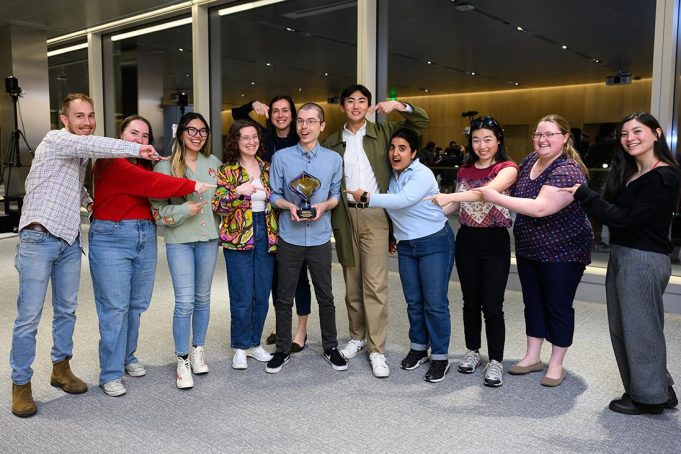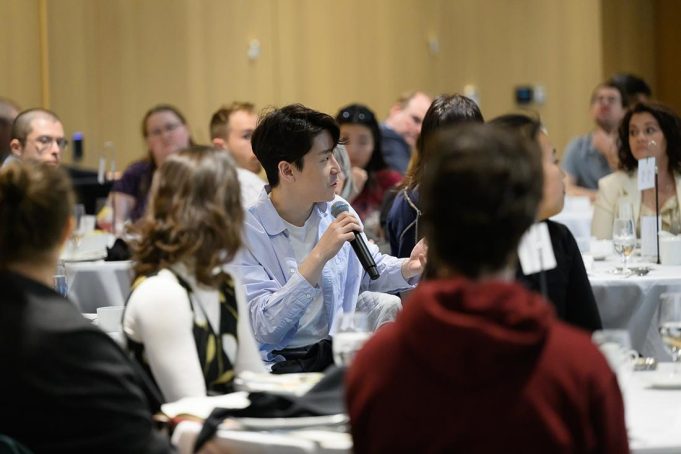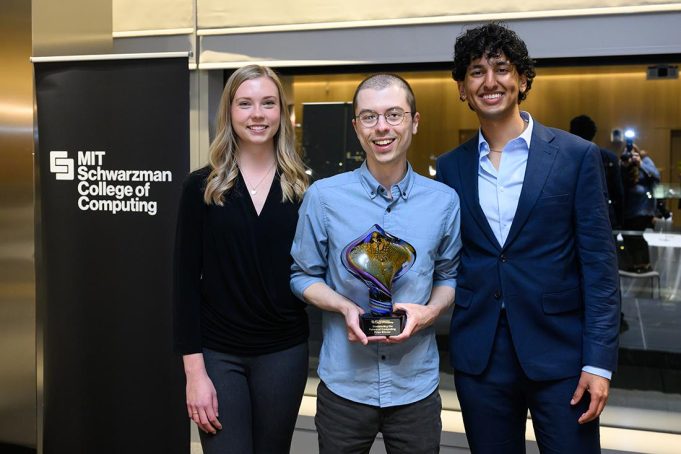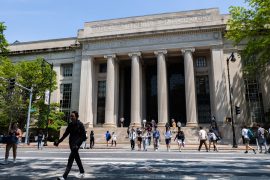Envisioning a future in which AI can decode whale song
Imaginative essay about a fictional breakthrough human-to-animal translation software wins this year’s Envisioning the Future of Computing Prize competition.
Can artificial intelligence enable humans to communicate with whales?
Much has been written lately about attempts by scientists who are harnessing the power of AI to enable humans to talk to other species one day. While some progress has been made in this field of study, the idea is still a far-fetched reality — except for in the imagined future of Christopher Maynard SM ’24.
A recent graduate of the Technology and Policy Program in the Institute for Data, Systems, and Society, Maynard dreamed up a work of speculative fiction about a breakthrough human-to animal translation technology, named Bioglossia, for the Envisioning the Future of Computing Prize, an essay contest that challenges MIT students to articulate their musings for what a future driven by advances in computing holds, for better or worse.
For the second year in a row, the competition asked students to describe in no more than 3,000 words, a particular computing-related technology that could, on balance, improve people’s lives and the ways it could do so, as well as the pitfalls and dangers associated with it. All entries were eligible to win a number of cash prizes.
In his paper, Maynard begins his tale by taking readers to a fictional press conference where researchers from Cornell University, in collaboration with the AI startup Metazoagloat, reveal a groundbreaking achievement: they have decoded two humpback whale dialects using a large language model trained on an extensive database of marine audio recordings. This remarkable discovery enables the translation of some humpback whale songs into English with a confidence level of 96 percent using the team’s innovative AI interpreter.
Crowned the $10,000 grand prize winner, Maynard won for his original narrative that covered key developments of and reactions to Bioglossia as a phenomenon and a product told in three parts from a broad spectrum of perspectives, including experts and laypeople, optimists and pessimists, and those in between.
Maynard says he came up with the concept for Bioglossia when listening to the soundtrack for the BBC series Blue Planet II while on a walk. “It got me thinking a lot about whales, particularly about their cognitive complexity and notions of culture and inner lives,” he says. “I wondered if cetaceans had a literary heritage, spiritual beliefs, or if they ever considered the inner lives of humans. And eventually, I found myself speculating on the prospect of proving that these animals actually use language and if we could ever hope to interpret their vocalizations.”
After being encouraged to submit an entry for the prize competition, Maynard says he knew that he wanted to contemplate these ideas further. “Naturally, the bridge between these thoughts and computing was some kind of artificial intelligence or large language model for facilitating translation.”
When asked if his viewpoint of AI may have changed during the course of writing his story, Maynard says that while he was initially optimistic and excited by the possibility of communication between humans and animals, he became convinced by some of his own characters’ worries about the dangers involved with the technology.
“With powerful AI tools, such as those that could allow people to control or negotiate with wildlife, I fear that self-serving individuals could inflict significant and irreparable harm to the natural environment. Despite my continued optimism for AI in general, I do now worry that it will be exceedingly difficult to halt the proliferation of its more nefarious applications.”
Inspiring creative thinking
Co-sponsored by the Social and Ethical Responsibilities of Computing (SERC), a cross-cutting initiative of the MIT Schwarzman College of Computing, and the School of Humanities, Arts, and Social Sciences (SHASS), with support from MAC3 Philanthropies, the contest this year attracted 67 submissions from undergraduate and graduate students across various majors, including nuclear science and engineering, media arts and sciences, electrical engineering and computer science, mathematics, chemical engineering, and others.
“The essays were absolutely awesome,” says Caspar Hare, associate dean of SERC for the
Schwarzman College of Computing and professor of philosophy.
Hare, who conceived the idea for the competition which launched last year, says that “the aim of the Envisioning the Future of Computing Prize is to inspire students to unleash their creative potential.” He adds that because many MIT students are, or will be, developing computing-related technologies, “we want to encourage them to consider the societal and ethical implications of their work as a forethought, not an afterthought. The competition offers a fun way for them to embrace such thinking.”
As evidenced by their highly imaginative essays, MIT students rose to the call of the challenge. One paper explored current and future advancements of open-source wearable artificial intelligence and the possibility that one day, human bodies and brains could be implanted with AI-enhanced neural interface devices. Another took readers to the year 2034 and introduced a new technology suite designed to serve as the primary platform for electoral processes and the expansion of democratization. It portrayed four scenarios that examined the possible effects of the new technology on individuals in the U.S. and India, the two largest democracies in the world.
Ahead of the submission deadline, students had the opportunity to test their ideas at workshops led by SERC postdocs who offered their help and advice on how to write a technology impact paper.
Determining the winner
As part of a two-stage evaluation process, all of the essays were first reviewed anonymously by a committee of faculty members from the college and SHASS. Three finalists were selected to move forward based on the papers the judges deemed to be the most articulated, thorough, grounded, imaginative, and inspiring.
In late April, a live awards ceremony was held where the finalists were invited to give 20-minute presentations on their entries for the second round. The event brought together about 100 faculty and students from all corners of MIT, as well as family and friends who came to show their support. The contenders also answered questions from the judging panel and audience members, sparking thoughtful and inspiring conversations throughout the evening on the societal impact of the fictional computing technologies presented.
The winner was ultimately determined by their final tally, which comprised 75 percent of their essay score and 25 percent of their presentation score.
“I was thrilled to participate in judging this year’s Envisioning the Future of Computing Prize competition and to witness the imagination of MIT students in action. It’s important to push students to think now about where computing technologies are going tomorrow — and to evaluate the risks and rewards they promise. The awards ceremony was a delightful experience, with charismatic presentations and challenging questions from the audience. I hope the prize will build from strength to strength,” says Kieran Setiya, a professor and philosophy section head in MIT’s Department of Linguistics and Philosophy.
In addition to Setiya, others on the judging panel included:
- Dan Huttenlocher, dean of the MIT Schwarzman College of Computing;
- David Kaiser, professor of the history of science and professor of physics;
- Yoon Kim, assistant professor of electrical engineering and computer science;
- Asu Ozdaglar, deputy dean for the MIT Schwarzman College of Computing and head of the Department of Electrical Engineering and Computer Science (EECS);
- Georgia Perakis, interim dean of the MIT Sloan School of Management;
- Manish Raghavan, assistant professor of information technology at MIT Sloan and EECS
- Julie Shah, head of the Department of Aeronautics and Astronautics;
- Brad Skow, professor of philosophy; and
- Nikos Trichakis, interim associate dean of SERC and associate professor of operations management.
The judges also awarded $5,000 to the two runners up: Siddu Pachipala, an undergraduate majoring in economics and political science, for his essay on generative AI in politics, and Sadie Zacharek, a PhD candidate in the Department of Brain and Cognitive Sciences, for her conception of a predictive model for mental health precision medicine. Additionally, the judges recognized 12 honorable mentions, each receiving a cash prize of $1,000.





